Crafting the Perfect Compost Bin: A DIY Adventure
Ever looked at a pile of kitchen scraps and thought there must be a greener way to dispose of them?
Building your own compost bin may be the fulfilling project you didn’t know you needed.
With just a handful of pallets and a good spot in the backyard, you can kickstart your composting journey, transforming waste into nutrient-rich gold for your garden.
Choosing the Ideal Location for Your Compost Bin
When it comes to setting up a compost bin, location is everything. You want a spot that’s just right—not too close, not too far.
But how do you find that sweet spot? Let’s dive into some key considerations.

Accessibility Matters
First things first: you need to be able to reach your compost bin easily. Imagine trudging through snow or rain just to toss in some kitchen scraps.
Not fun, right? That’s why it’s crucial to place your bin in a location that’s convenient for you.
- Easy Access: Make sure the spot is accessible for regular waste additions.
- Distance from the House: Aim for about 100 feet away. This keeps odors at bay while still being close enough for convenience.
One gardener shared,
“It felt like putting this here created the space maybe and kind of gave me a cornerstone for my garden.”
This highlights how the right location can enhance your gardening experience.
Think About Equipment Access
Do you plan to use a tractor or other equipment to manage your compost? If so, you’ll need to ensure there’s enough space for maneuvering.
A cramped spot won’t do.
- Tractor Access: Choose a location that allows for easy entry and exit with machinery.
Imagine trying to squeeze a tractor into a tight corner. It’s like trying to park a bus in a compact car space—not ideal!
Consider Natural Drainage
Water management is another critical factor. Placing your compost bin on a hill can offer natural drainage benefits. This helps prevent waterlogging, which can turn your compost into a soggy mess.
- Hill Placement: A slight incline can aid in water runoff, keeping your compost dry and aerated.
Think of it like this: a well-drained compost pile is like a well-ventilated room. It breathes better and works more efficiently.
Creating a Garden Cornerstone
Choosing the right spot for your compost bin can also serve as a foundation for your garden. It can define the space and inspire further gardening projects.
As one gardener friends noted,
“Putting this here created the space maybe and kind of gave me a cornerstone for my garden.”
This sentiment captures how a simple compost bin can transform your outdoor area.

Final Thoughts
In summary, selecting the ideal location for your compost bin involves balancing accessibility, equipment access, and natural drainage.
By considering these factors, you can create a functional and inspiring space for your gardening endeavors.
So, where will you place your compost bin? The choice is yours, but remember: the right spot can make all the difference.
Materials and Construction Techniques
When it comes to building a compost bin, the materials you choose are crucial. Not just any pallet will do.
You need to be selective. Why? Because safety and longevity are at stake. Let’s dive into the details.
1. Use Heat-Treated Pallets for Safety
First things first, always opt for heat-treated (HT) pallets. These are essential for safe composting.
Why? Heat treatment kills pests without using harmful chemicals. You might be wondering, “How do I know if a pallet is heat-treated?” Look for the HT label. As one user noted,
“Look for the HT this one that label was pretty hard to find.”
It can be tricky, but it’s worth the effort.

Avoid pallets treated with chemicals like methyl bromide (MB). These are sprayed with chemicals to kill bugs, which is not what you want in your compost area. Remember, safety first!
2. Opt for Heavy-Duty Materials for Longevity
Next, consider the durability of your materials. Heavy-duty pallets are a great choice. They can withstand the elements and the weight of your compost. Think of it like building a house. Would you use flimsy materials? Of course not! The same logic applies here.
In a recent project, seven pallets were used. Only one had the HT label, but all were heavy-duty. This ensures that your compost bin will last for years to come.
3. Bolts and Screws Ensure Sturdiness
Now, let’s talk about construction. How do you hold everything together? Bolts and screws are your best friends. They provide the sturdiness needed to keep your compost bin intact. Imagine trying to build a bridge with glue. It just wouldn’t work, right?
For the attachment of the pallets, bolts were used. They were even reused, adding an eco-friendly touch to the project. It’s a win-win situation: sturdy construction and sustainability.

Additional Reinforcements
Don’t stop at bolts and screws. Consider additional reinforcements. This could be extra wood panels or metal brackets.
The goal is to create a structure that can handle the weight and activity of composting.
Think of it like wearing a seatbelt. You might not need it every day, but when you do, you’ll be glad it’s there.
Reinforcements are your compost bin’s seatbelt.
Final Thoughts on Material Selection
Choosing the right materials and construction techniques is like laying a strong foundation. It sets the stage for successful composting.
Remember to prioritize safety with heat-treated pallets, choose heavy-duty materials for longevity, and ensure sturdiness with bolts and screws.
By following these guidelines, you’ll have a compost bin that’s not only functional but also safe and durable.
So, are you ready to start building? Watch along below to see how it’s done.
So, to recap…
Securing and Reinforcing Your Compost Bin
Creating a compost bin is a fantastic way to recycle organic waste and enrich your garden soil. But have you ever thought about how to keep it sturdy and long-lasting?
Stability is key. Without it, your compost bin might just collapse under the weight of decomposing materials.
So, how do you ensure your compost bin stands the test of time?

Install Steel Stakes or Rebar
One of the most effective ways to stabilize your compost bin is by using steel stakes or rebar. These materials are strong and durable, providing the necessary support to keep your bin upright.
Imagine trying to hold up a tent without stakes.
It would just flop over, right? The same principle applies here.
Drive the steel stakes or rebar deep into the ground at each corner of your bin. This will anchor the structure firmly, preventing any unwanted movement.
You might be wondering, “Is this really necessary?”
Well, if you want your compost bin to withstand the elements and the pressure of decomposing materials, then yes, it is.

Additional Bracing for Extra Support
While steel stakes or rebar provide a solid foundation, additional bracing can further enhance stability. Think of it like adding a belt to your pants.
Sure, they might stay up without it, but the belt gives you that extra security.
Use leftover wood or other sturdy materials to create braces across the top and sides of your bin.
This will prevent any lateral movement and ensure that your bin remains intact, even when filled to the brim with compost.
As one experienced builder put it, “Make it strong, make it don’t move, that’s just what I’m used to doing so it seems pretty solid to me now.”
Creative Solutions: Repurposing Leftover Wood
Why not get a little creative with your compost bin? Repurposing leftover wood not only saves money but also adds a unique touch to your garden.
Plus, it’s a sustainable choice that aligns with the eco-friendly nature of composting.
Look around your garage or shed.
Do you have any old wooden planks or beams lying around? These can be used to reinforce your compost bin.
Attach them horizontally or diagonally across the structure for added strength. Not only will this prevent movement, but it will also give your bin a rustic, charming appearance.

Optional Fasteners: Two-Hole Clamps
If you’re looking for an extra layer of security, consider using two-hole clamps as optional fasteners.
These clamps can be attached to the steel stakes or rebar, providing additional support to the wooden braces. It’s like adding a lock to your front door.
Sure, the door might stay closed without it, but the lock gives you peace of mind.
Simply screw the clamps into place, ensuring that they are tightly secured. This will prevent any shifting or wobbling, even in harsh weather conditions.
Remember, the goal is to create a compost bin that is as solid as a rock.
Conclusion
In conclusion, securing and reinforcing your compost bin is essential for its longevity and effectiveness.
By installing steel stakes or rebar, adding additional bracing, and repurposing leftover wood, you can create a sturdy and sustainable structure.
Optional fasteners like two-hole clamps provide extra security, ensuring that your bin remains stable even under pressure.
Remember, a well-built compost bin not only benefits your garden but also contributes to a healthier environment.
So, take the time to reinforce your bin and enjoy the rewards of rich, nutrient-dense compost for years to come.
After all, a strong foundation is the key to success in any project.
If you are not yet ready to build your own composter or just want to try composting out before you commit to a more permanent structure like this, then check out a super affordable piece of composting kit for your garden that you can assemble in a few minutes!





